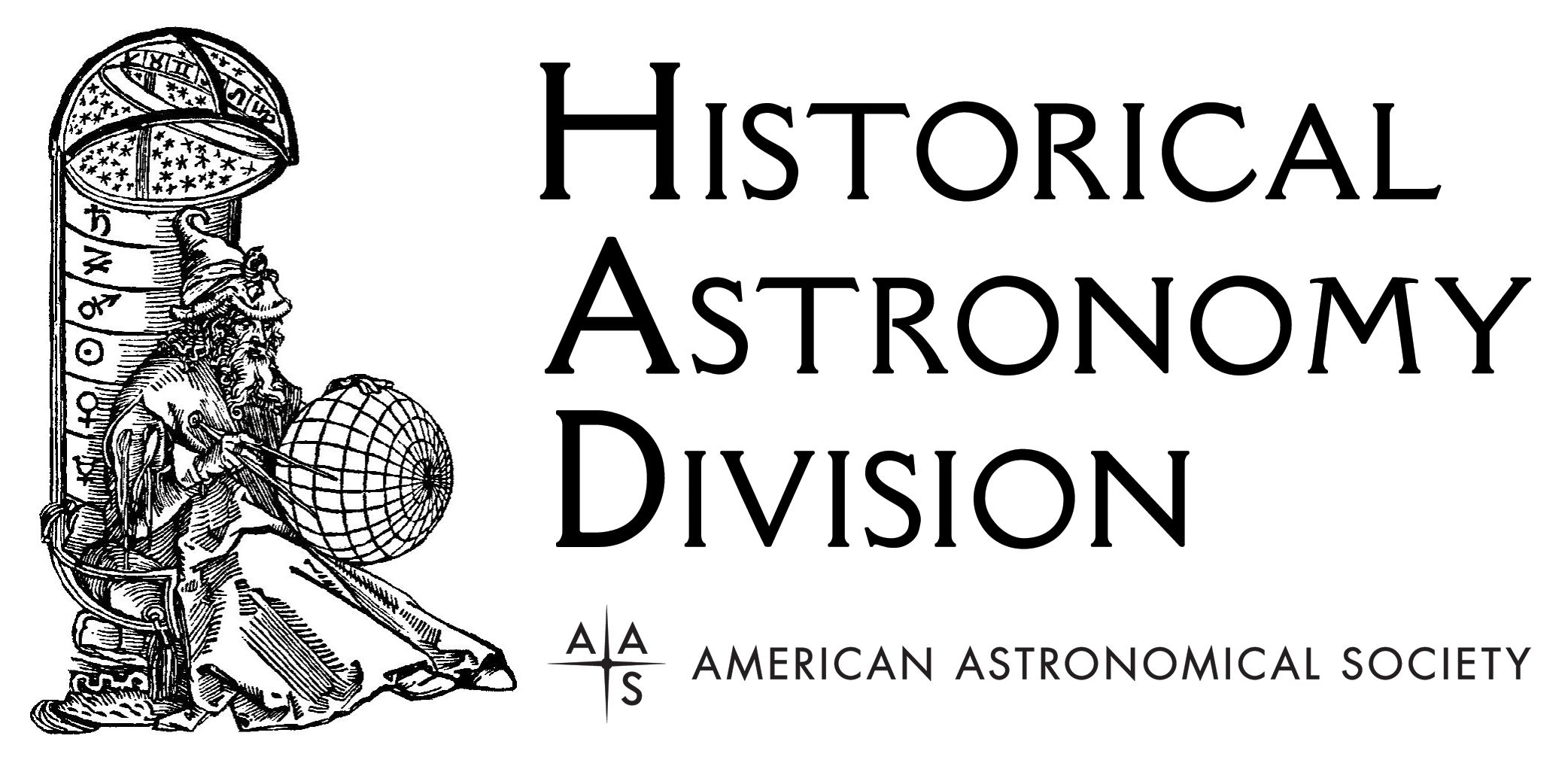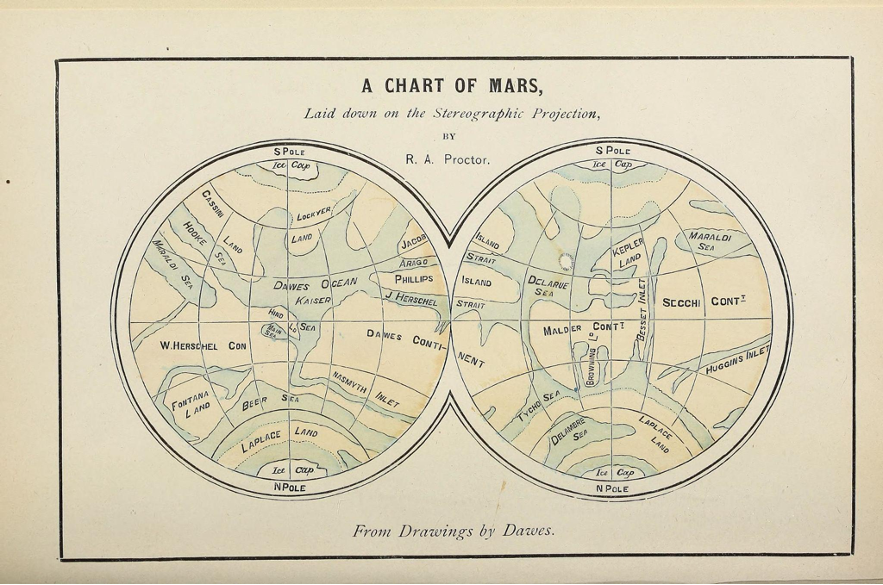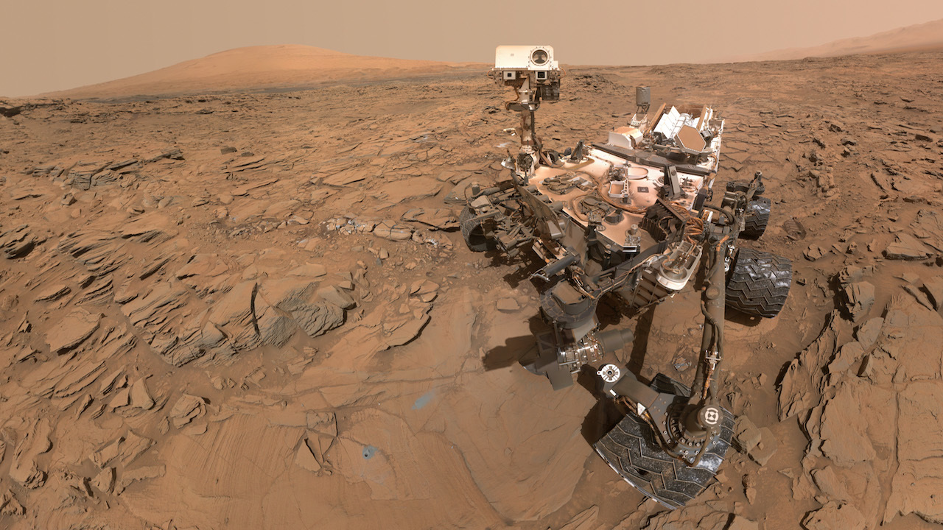This Month in Astronomical History: July 2023
Aneka Kazlyna Columbia University
 Each month as part of this series from the AAS Historical Astronomy Division (HAD), an important discovery or memorable event in the history of astronomy will be highlighted. This month's author, Aneka Kazlyna, writes about our cultural engagement with the planet Mars. Interested in writing a short (500-word) column? Instructions along with previous history columns are available on the HAD web page.
Each month as part of this series from the AAS Historical Astronomy Division (HAD), an important discovery or memorable event in the history of astronomy will be highlighted. This month's author, Aneka Kazlyna, writes about our cultural engagement with the planet Mars. Interested in writing a short (500-word) column? Instructions along with previous history columns are available on the HAD web page.
Mars: From Imagination to Exploration
Mars has captivated our imagination for thousands of years, from taking on roles in ancient mythology, to detailing early maps of the night sky, and to providing the possibility for human expansion into space. As we have continued to better understand our red neighbor, July is an appropriate month to stop and ponder its history and its potential for understanding life.
- July 1895: The Atlantic published "Mars III: Canals" by Percival Lowell. This was a pre-publication of material from Lowell's 1896 book and it was part of a series of four related essays.
- 14 July 1965: Mariner 4 sent 22 photos of Mars back to Earth.
- 21 and 25 July 1973: USSR probes Mars 4 and Mars 5 launched. They did not complete their missions though Mars 5 presumably made landfall. (Mars 6 and Mars 7 launched in August were successful.)
- 4 July 1997: Pathfinder and Sojourner rovers landed on Mars.
- 7 July 2003: MER-B Opportunity rover launched.
- 19 July 2020: United Arab Emirates launched Hope probe aboard Japan's H-2A lifter.
- 23 July 2020: China launched Tianwen-1 from the Wenchang Spacecraft Launch Site on the island of Hainan atop a Long March 5 heavy-lift launch vehicle.
- 30 July 2020: Perseverance rover lifted off aboard a United Launch Alliance Atlas V.
During the 1800s, long before rovers rolled on its surface, many astronomers made maps of Mars. Astronomers Johann Mädler and Wilhelm Beer made maps of Mars based on their own observations which highlighted the dark and light areas of its surface. Later in 1864, astronomer William Dawes made drawings of Mars which would inspire the maps of Richard Anthony Proctor. Proctor depicted the light and dark parts of Mars as vast landmasses resembling continents and expansive bodies of water akin to seas, accompanied by icy caps situated at the planet's poles.1
In 1877, Giovanni Schiaparelli observed distinct features on the surface of Mars, which he termed "canali," or channels. This designation was mistakenly translated into English as "canals.” Percival Lowell, an astronomer from Boston, was captivated by the concept of “canals” and conducted meticulous observations using his personal telescopes. In his seminal 1906 book, Mars and Its Canals, Lowell produced a detailed map of over hundreds of canals which spurred many debates about the existence of these canals and the possibility of life on Mars.2 In 1907, Alfred Wallace published the book, Man’s Place in the Universe, in which he critiqued Lowell’s ideas about Martian canals and concluded that Earth was the only planet that supported life.3
An often-overlooked part of the history of our study of Mars and the search for life can be found in the work of Gavriil Adrianovich Tikhov. Tikhov was born in 1875 in Smalyavichy, Belarus. From 1906 to 1941, he worked at the Pulkovo Observatory near Saint Petersburg and Alma-Ata in Kazakhstan. Tikhov studied the light from Mars to compare it with light reflected from plants growing in high-altitude environments on Earth. In his works, Tikhov wrote that he had asked the scientist K.A. Timiryazev about whether Percival Lowell has observed chlorophyll bands on Mars. Tikhov noted that Lowell had been searching for these bands on Mars, but had not found them. Tikhov himself argued that some plants could grow on Mars without chlorophyll. Interestingly, he described Mars as having low blue vegetation. He spent his life studying many species of plants growing in Siberia in harsh climates, which he considered as analogs for the Martian climate. For Tikhov, life on Mars developed inevitably under generally different conditions than on Earth. His technique of using terrestrial analog sites on Earth to understand Mars remains part of astrobiology today.4,5
These astronomers’ debates about life on Mars were largely based on very meager evidence, none of which was collected from Mars itself. However, this changed decades later with actual missions to our red neighbor. During the 1960s, the USA and the USSR attempted multiple missions to Mars. In 1964, NASA launched Mariner 3, the first flyby attempt of Mars. The mission failed, but a mere 17 days later on 14-15 July 1965, Mariner 4 was launched and sent back the first images of Mars. These images, played back from a tape recorder, showed lunartype impact craters. They disproved Lowell’s and his contemporaries' ideas about Martian canals. Viking 1 landed on Mars on 20 July 1976 and Viking 2 soon followed on 3 September 1976. They captured digital images and data on the surface of Mars. The two landers undertook three biology experiments aimed at detecting potential indications of life. Although these experiments revealed unexpected chemical activity in the Martian soil, they did not yield conclusive evidence supporting the existence of living microorganisms in the soil near the landing sites.6,7
Since then, NASA sent several more missions to Mars to study its geology and atmosphere, and to search for markers of life. The Pathfinder mission and its Sojourner rover, which landed on 4 July 1997, discovered silica and conglomerate rocks on the planet, suggesting the previous existence of water and volcanic activity. The Spirit and Opportunity twin rovers landed on 3 January and 24 January 2004 respectively.8 They made numerous discoveries via geological experiments, including evidence for the presence of both acidic and freshwater. The Curiosity rover, which landed on 6 August 2012, detected sulfur, oxygen, nitrogen, phosphorus, and carbon, all of which signify the potential for life to have once existed.
Water trapped within rocks was released, allowing for the characterization of hydrogen on the planet. Most recently, Perseverance, which landed on 18 February 2021, found the Jezero crater to have once had flowing lava, rivers of water, and heavy flooding. Its discovery of deltas holds promise for the discovery of biological material within the sediment. Perseverance has also been collecting and caching geological samples that must be collected and analyzed.9,10
These samples will be collected as part of NASA’s Mars Sample Return mission and by 2033, they should be returned to Earth. The Martian rock and soil samples could offer insight into the question of whether or not Mars could have ever supported life.

Fig. 1: Proctor’s Chart of Mars based on drawings by Dawes. Image credit: Digital Museum of Planetary Mapping. (“The Surface of Mars by Rev. William Rutter Dawes, FRAS,” Flowers from the Sky by Richard Anthony Proctor; Strahan, 1879; Chatto & Windus 1883).

Fig. 2: Mars according to Gavriil Adrianovich Tikhov, 1953.

Fig. 3: The Rover Perseverance, 2021. Image Credit: NASA.
References
- https://planetarymapping.elte.hu/proctors-mars-maps-1865-1892.
- Lowell, Percival. 1906. Mars and Its Canals, New York, The Macmillan Company.
- McKim, R. and Marriott, R.A., 1988. "Dawes' Observations of Mars," 1864-65. Journal of the British Astronomical Association, Vol. 98, No. 6, p. 294-300.
- Tikhov G.A. 1953. Astrobiology. Moscow: Molodaya Gvardiya Publishing.
- Tikhov, G.A. "Is Life Possible on Other Planets?", Journal of the British Astronomical Association 65: 193–204.
- https://mars.nasa.gov/resources/26907/curiositys-sam-instrument/
- https://mars.nasa.gov/news/1767/nasa-rover-finds-active-and-ancient-org…
- https://www.nasa.gov/mission_pages/mer/overview/index.html
- https://www.space.com/17745-mars-pathfinder-sojourner-rover.html
- https://solarsystem.nasa.gov/missions/opportunity/in-depth/

